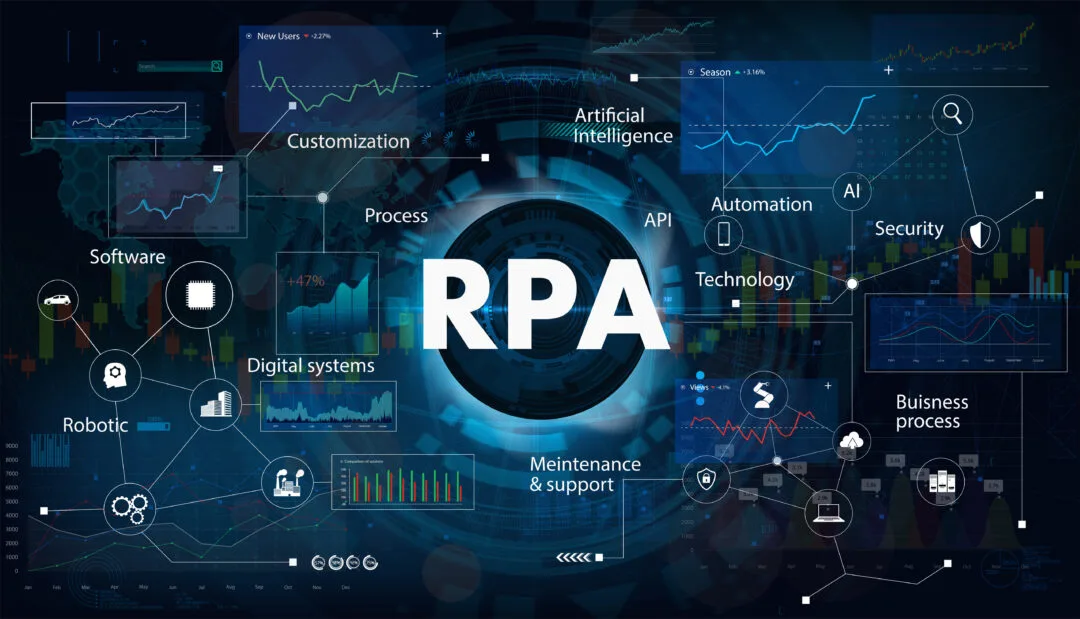In today’s rapidly evolving technological landscape, businesses are constantly seeking innovative ways to enhance productivity, reduce costs, and improve operational efficiency. One round breaking solution that has gained significant traction is Robotic Process Automation (RPA).
RPA is revolutionizing traditional workflows by automating repetitive, rule-based tasks, freeing up human workers to focus on more strategic and creative endeavors. In this blog post, we will delve into the world of RPA, exploring its benefits, applications, and the impact it has on organizations.
Robotic Process Automation (RPA) is a software technology that allows organizations to automate business processes by creating software “bots” that mimic the actions of human users. RPA bots can be used to automate a wide variety of tasks, including data entry, form processing, and invoice validation.
RPA is a powerful tool that can help organizations to improve efficiency, reduce costs, and free up employees to focus on more strategic work.
Benefits of RPA
1. Enhanced Efficiency: By automating repetitive tasks, RPA eliminates human error and significantly improves process efficiency. Bots can work around the clock, completing tasks at a much faster pace than their human counterparts, leading to increased productivity.
2. Cost Reduction: RPA enables organizations to reduce costs by eliminating the need for manual labor and streamlining processes. With automation, businesses can accomplish more with fewer resources, resulting in substantial cost savings.
3. Scalability and Flexibility: RPA offers unparalleled scalability, allowing organizations to easily adjust their automation capabilities to match fluctuating workloads. It can be seamlessly integrated with existing systems, making it a flexible solution for businesses of all sizes.
4. Improved Accuracy and Compliance: Bots adhere strictly to predefined rules and processes, minimizing the risk of errors and ensuring compliance with regulations. RPA also provides detailed logs and audit trails, making it easier to track and monitor activities.
Applications
1. Data Entry and Extraction: RPA can automate the process of entering data into multiple systems and extracting relevant information from various sources, reducing manual effort and improving data accuracy.
2. Customer Service and Support: Bots can handle customer queries, provide support, and perform tasks like account verification, order tracking, and refunds. This leads to faster response times and improved customer satisfaction.
3. Finance and Accounting: RPA is highly valuable in automating financial processes such as invoice processing, accounts payable/receivable, and reconciliations. By automating these tasks, organizations can streamline operations, reduce errors, and improve financial accuracy.
4. HR and Employee Onboarding: RPA can simplify and expedite employee onboarding processes by automating tasks like document verification, data entry, background checks, and provisioning access to company systems.
5. Supply Chain Management: RPA can optimize supply chain processes by automating inventory management, order tracking, and supplier communication, leading to improved efficiency and reduced costs.
Future of RPA
As technology continues to advance, the future of RPA looks promising. The integration of artificial intelligence (AI) and machine learning (ML) capabilities with RPA will enable bots to handle more complex tasks, learn from data, and make intelligent decisions. This evolution will unlock even greater potential for automation, transforming entire industries and revolutionizing the way businesses operate.
Tools and Tech
RPA tools are the software that helps users to configure various tasks to get automated. Most of the organizations have periodic and repetitive tasks such as data entry, data extraction, report generation, etc. These tasks are manually performed on the software by the employees. Such repetitive tasks can be easily automated with the help of bots. The software that utilizes bots for performing automation is called the RPA Tool.There are several RPA tools and technologies available in the market. Here are some popular ones:
- UiPath
- Automation Anywhere
- Blue Prism
- Pega
- WorkFusion
- Kofax
- Microsoft Power Automate
Each tool has its own set of features, capabilities, and pricing models. When selecting an RPA tool, it’s important to consider factors such as ease of use, scalability, integration capabilities, and support for the specific systems and applications used in your organization.
Overcoming challenges in RPA
Robotic Process Automation (RPA) can bring numerous benefits to organizations by automating repetitive and rule-based tasks. However, implementing RPA solutions can also pose various challenges. Here are some common challenges associated with RPA and suggestions for overcoming them:
1. Process Standardization: RPA is effective with standardized processes, but overcoming challenges in inconsistent or variable organizations requires analyzing and streamlining processes. Identifying commonalities and standardizing variations can ensure smoother implementation.
2. Process Complexity: Combining RPA with advanced technologies like machine learning and NLP can effectively automate complex processes with multiple decision points, exceptions, and unstructured data. This approach effectively tackles more intricate tasks.
3. Legacy System Integration : Organizations often have legacy systems that aren’t suitable for seamless integration with RPA. To bridge the gap, develop connectors or middleware tools, and collaborate with IT to explore APIs or screen scraping techniques for interaction with legacy systems.
4. Change Management : RPA implementation can disrupt processes and job roles, causing resistance and skepticism among employees. To overcome this, involve employees from the early stages, conduct training sessions, highlight benefits, and encourage open communication. This will help reduce mundane tasks and focus on value-added work. Addressing concerns and addressing concerns will ensure a smooth transition.
6. Security and Compliance : RPA implementation can introduce security risks if not managed properly. Focus on security and compliance, implement access controls, encryption, and monitoring mechanisms, and involve cybersecurity and compliance teams to assess and mitigate risks.
7. Continuous Improvement : RPA should not be a one-time solution; regularly evaluate and optimize automated processes, analyze bot performance metrics, identify areas for improvement, and apply iterative enhancements. Encourage employee feedback and engage in ongoing process optimization efforts.
Proactively addressing challenges and adopting a holistic RPA approach enable organizations to overcome obstacles, maximize automation’s potential, and drive efficiency and productivity.
RPA and AI
RPA and AI can enhance automation solutions by combining cognitive capabilities, enabling them to handle unstructured or semi-structured data, understand natural language, and make intelligent decisions. This integration allows RPA bots to perform complex tasks, handle exceptions, and interact with users in a more human-like manner. For instance, an RPA bot integrated with AI can analyze and extract information from documents, such as invoices or contracts, using natural language processing (NLP) techniques. This combination leads to advanced automation solutions that streamline processes, provide cognitive capabilities, improved accuracy, and scalability, enabling organizations to automate a wider range of tasks and achieve higher levels of operational efficiency.
Success Stories
Robotic Process Automation (RPA) has gained popularity across various industries for its ability to automate repetitive tasks and streamline business processes. Here are a few case studies and success stories of organizations that have implemented RPA:
1. UiPath and Deutsche Bank:
Deutsche Bank used UiPath’s RPA platform to automate manual and rule-based processes, resulting in time and cost savings in reconciliation and onboarding. This reduced errors and improved operational efficiency.
2. Blue Prism and Coca-Cola Hellenic Bottling Company (CCHBC):
CCHBC, a major Coca-Cola bottler, utilized Blue Prism’s RPA platform to automate back-office processes, reducing processing time by 50%, improving data accuracy, and increasing employee satisfaction.
3. Automation Anywhere and Telefónica O2:
Telefónica O2, a top telecommunications provider, utilized Automation Anywhere’s RPA platform to automate billing and customer service processes, resulting in a 92% reduction in processing time and enhanced customer satisfaction through faster issue resolution.
4. WorkFusion and Standard Chartered Bank:
Standard Chartered Bank used WorkFusion’s RPA platform to automate KYC processes, reducing processing time by 70% and increasing regulatory compliance by gathering and verifying customer information from multiple sources.
These case studies highlight the diverse applications of RPA across industries, showcasing how organizations have achieved improved efficiency, cost savings, and customer satisfaction by automating their processes.
Security
RPA security involves measures and practices to protect systems and data, using software robots to automate repetitive tasks and processing sensitive information. Key aspects of RPA security include ensuring data integrity, preventing access to sensitive information, and ensuring data privacy.
1. Authentication and Authorization: Implement strong authentication mechanisms to ensure that only authorized personnel can access the RPA system. Use secure credentials and enforce access controls based on roles and responsibilities.
2. Secure Development Practices: Follow secure coding practices during the development of RPA workflows and scripts. This includes using secure programming languages, validating and sanitizing input data, and implementing secure communication protocols.
3. Encryption: Apply encryption techniques to protect sensitive data at rest and in transit. Use strong encryption algorithms and ensure that encryption keys are properly managed and protected.
4. Access Controls: Implement granular access controls to limit the actions that each software robot can perform. Restrict access to critical systems and data based on the principle of least privilege.
5. Audit and Logging: Enable comprehensive logging of RPA activities, including user actions and system events. Regularly review and monitor logs to detect any suspicious or unauthorized activities. Implement audit trails for accountability and compliance purposes.
6. Secure Configuration Management: Maintain secure configurations for RPA components, including the underlying infrastructure, RPA software, and associated applications. Apply necessary security patches and updates in a timely manner.
7. Data Privacy and Compliance: Ensure compliance with applicable data protection and privacy regulations, such as GDPR or HIPAA, depending on the nature of the data processed by the RPA system. Implement mechanisms to handle sensitive data appropriately and securely.
RPA security should be holistically approached and aligned with your organization’s cybersecurity strategy. Regular assessments, vulnerability scanning, and penetration testing can identify and address potential security weaknesses in RPA implementation.
Robotic Process Automation is reshaping the way organizations operate by automating repetitive, rule-based tasks and freeing up human workers for more strategic and value-added activities. The benefits of RPA, including enhanced efficiency, cost reduction, scalability, and improved accuracy, are driving its adoption across various industries. With continued advancements in technology, RPA is set to become an indispensable tool for businesses seeking to optimize their processes, increase productivity, and stay competitive in the digital.
If you enjoy reading our articles, take a minute to subscribe to our Newsletter. Click Here! (It’s Free, No Spam!)



